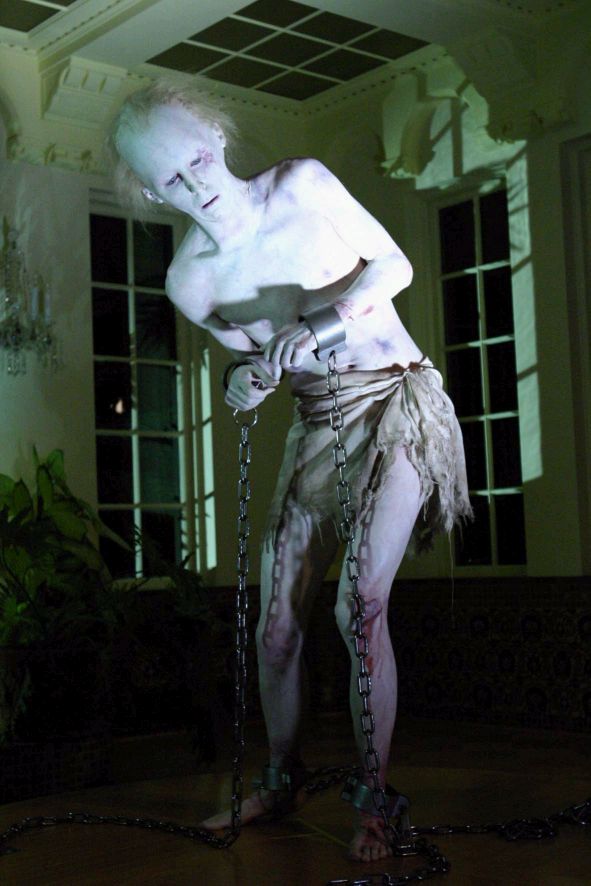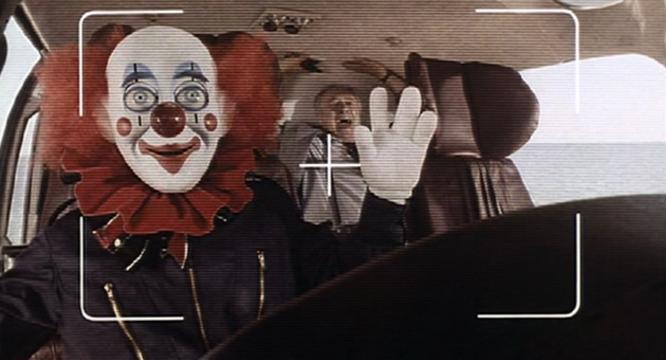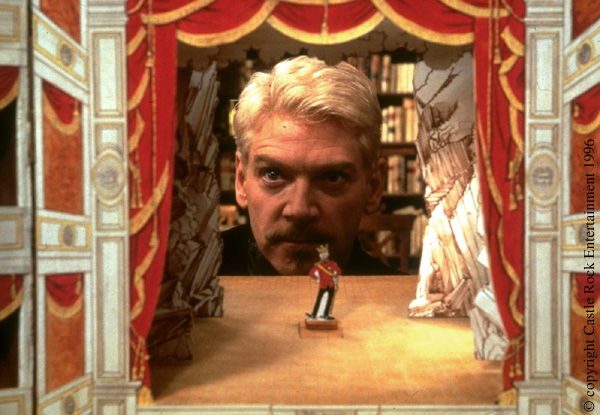The Top-10 Films and TV Shows from Within Films and TV Shows
No matter what film or TV show you’re watching, the word of the day is going to be verisimilitude; that is, every film, no matter how fantastic or whacked out or imaginary, is going to claim to be the real world. Genre films (sci-fi and fantasy in particular) may imagine an alternate version of Earth, but they are still based in a grounded reality of some sort.
And nothing can pull you out of that film’s reality better than the pop culture within that universe. If you’re watching a romantic comedy, and the characters are talking about, say, “Jersey Shore,” then you know it’s the real world. But when you see an episode of “DJ Laser” playing in the background of “Robocop,” you begin to realize that this film is one small nudge away from actual reality. Some call it the “555” effect (as in, all fake telephone numbers begin with 555, which serves as a clarion call for the film’s falseness). The proper German term is verfremdungseffekt.
In the spirit of that ecstatic state of pop culture half-truth, I have compiled the following list of the best films-within-films and TV-shows-within-TV-shows to ponder and enjoy. Here are the shows we like from inside the shows we like.
10) “Satan’s Alley”
From “Tropic Thunder” (2008)

Ben Stiller’s “Tropic Thunder” was about a group of actors, filming a jungle mayhem film, who find themselves in real peril by real bad guys. The film opened with the sad career trajectories of each of the struggling, would-be players, including limp action films like Ben Stiller’s “Scorcher VI,” and unfunny raunch comedies like Jack Black’s “The Fatties, Fart 2.”
The crown jewel of this set of fake preview, though, was a so-called “prestige” picture, featuring Robert Downey, Jr.’s Kirk Lazarus in a film called “Satan’s Alley,” which was a hyper-stylized weepy romance about 18th century Irish monks in gay relationships. In an episode of “South Park,” a character once observed that all indie films are about gay cowboys eating pudding. When “Brokeback Mountain” was released in 2005, all bets were off, and Stiller wrote this savvy and funny parody preview for “Satan’s Alley.”
Call me weird, but I’d love to watch “Satan’s Alley.” It seemed to me to be the right blend of earnest romance, gay exploration, and outright lurid sex. Let’s see the pretentious, hard-working thespian in bed with Tobey Maguire, shall we?
9) “La Fin Absolue du Monde”
From “Cigarette Burns” (2005)

As part of the notorious “Masters of Horror” series, the indispensible John Carpenter directed a film that he considered to be a quick one-off, but that I feel is a rather good, and a wonderfully twisted way of showing how far cinema can go, and how dramatically it can affect people. It was called “Cigarette Burns” (after the visible cue marks one sees at the ends of film reels, a term invented for “Fight Club”), and it was about a mad film collector (Udo Kier) who hires an investigator (Norman Reedus) to track down the world’s rarest film, a short called “La Fin Absolue du Monde,” or “The Absolute End of the World.”
It turns out that “La Fin Absolue du Monde” is so rare because anyone who watches it goes insane, and induces murders and suicides even amongst the most wholesome and hearty of souls. It was a disaster at its premiere back in the 1930s, and has been lurking in the scarier periphery of snuff film circles ever since.
We only get to see snippets of “La Fin Absolue du Monde” in “Cigarette Burns,” but we do know that it contains the mutilation of an actual angel. If a friend or a colleague approached me and told me they had a reel of a film that makes you go mad and commit suicide, I would insist that we watch it immediately. If it’s real, what a way to go. If it’s not, well, you can brag.
8) Whatever that was at the beginning of “FX2”
From “FX2” (1991)

The idea behind the “F/X” movies (using practical movie special effects to fight crime) is a sadly dated one, as all film effects have largely moved into the realm of CGI; one cannot fight crime with CGI. The films, then, stand as kind of cheesy, but immensely entertaining celebrations of the hard-working, dashing, gore-obsessed engineers who once constructed the ooey-gooey monsters and bloody gunshot wounds of our childhoods. Bryan Brown and Brian Dennehy are also at their cheesy comic best in the films, and they move with a wonderfully comedic clip that one rarely finds in even good action films of the day.
The opening of “FX2” is, of course, the filming of a film-within-a-film, and features a shootout between a group of cops, and a cross-dressing super-cyborg that bleeds glowing purple ooze, and shoots missiles from its severed arm sockets. The title of this film is never revealed, and the rest of its story is never discussed. It’s a stand-alone FX scene with a cross-dressing robot.
I would watch that movie. I really want to watch that movie. Any movie with a missile-launching, purple-ooze-encrusted, transvestite robot is my kind of movie. As the fake opening began, I even started to wish that “FX2” would never begin, and this weird-ass sci-fi thing would continue apace. Perhaps if Richard Franklin went back in time, we could convince him to make it.
7) “Don’t”
From “Grindhouse” (2007)
The Tarantino/Rodriguez two-punch “Grindhouse” remains, in my mind, one of the more purely cinematic films of the last decade. It was a film predicated on actual theatrical experience, rather than a dull bank of easily downloaded and digested images. The film was scratched. It was double feature. The films were sloppy and weird and savvy homages to a certain kind of “B”-film of decades past. It’s one thing to see the films on video. It’s actually something else entirely to see it in a theater.
And, most memorably from “Grindhouse” were the entertaining fake trailers directed by special guest directors. There was Rob Zombie’s “Werewolf Women of the SS,” there was Eli Roth’s “Thanksgiving,” and, most enjoyably, there was Edgar Wright’s “Don’t.”
“Don’t” remained obscure. Its story was not discussed, and the scenario never made clear. But the degraded images, spooky narration, and grave warnings only made us horror movie fans lick our chops in giddy anticipation. “Don’t” made us hungry for a horror film that sounded more exciting than most of the real horror films being released. If you want to go in the basement… DON’T!
6) “Corporate Cops”
From “The Awful Truth” (1999)
Michael Moore is often vilified in this country as either an ignorant rabble-rouser, or a sloppy journalist with a left-wing agenda. I’ve always seen him as a working-class satirist, who clearly does have an agenda, and has the gall to stand by his beliefs. I admire a lot of his film and TV work, most of all, this 1999 TV series “The Awful Truth,” which was a weekly 30-minute show that tackled whatever corporate malfeasance he could expose that week, and regularly mocked politicians on both the left and the right.
In a short (which he would subsequently reuse in 2003’s “Bowling for Columbine”), Moore questioned why it was that reporting of crime had risen while crime rates themselves had dropped. He approached the producer of the infamous TV reality show “Cops,” and asked why petty criminals were so hot at the time, and why exposing horrible white-collar criminals (who bilked the American people out of billions) was not on his radar. The producer replied that carrying a guy in a suit into a cop car was not good TV, while a shirtless robber was very good TV indeed.
Moore then filmed an entertaining segment where he proposed a “Cops”-like spinoff called “Corporate Cops.” The new show would feature tax-evaders, greedy CEOs, and other Mephistophelean assholes running like mad from John Law. I don’t know about you, but I would watch that show in a heartbeat. Who wouldn’t want to see a doughy white embezzler in a suit trying to outright one of the state’s finest?
5) “The Moustrap”
From “Hamlet” (1601)

If you will excuse a slight classic digression…
So you’re the rightful heir to your father’s throne, but, by some legal trickery, your uncle became king instead. What’s more, your father’s ghost has appeared to you and told you outright that your uncle killed him. It’s your moral obligation to kill him and take your rightful place.
Hamlet, though, reacts as, I think, most of us would. With a painfully heartfelt ambivalence. Sure you’d get what you want, but you would have to commit murder. Hamlet’s indecision on the matter leads to one of the most famous (if not the single most famous) plays-within-plays in literary history: “The Moustrap.” He writes a play (!) which theorizes how the murder went down, and, based on how Claudius reacted, would then commit murder accordingly.
The play itself – which mirrors the story of “Hamlet” – is a bombastic affair with long speeches and heartfelt line-readings that feel forced and awkward. “Forced and awkward” may not sound like many people’s cup of tea, but sometimes the author’s intentions can be far more interesting than the actual content of a film or play. Watching “The Mousetrap” with the Danish court, while Hamlet is frothing about on stage, and Claudius is shifting uncomfortably in his seat would be a ceaselessly entertaining experience.
4) “Crappon Inna Hat”
From “The Maxx” (1993)

The Maxx is a masked superhero – in his mind. In reality, he’s a down-and-out homeless man who takes advantage of the kindness of his best friend Julie. The Maxx also seems to occasionally shift from one reality (this one) to another (a mythical Australian outback), where he actually is a monster-fighting badass.
Sam Kieth’s famed cult comic is still one of the weirdest and most elaborate ever written, and is still beloved by cult audiences as a revolutionary oddity about gender dynamics, rape, feminism, and the practical uses of magic. Keith likes to remain oblique, and would only drop hints as to the true nature of what was going on. Hints would come by truly obtuse means: a bad guy’s soliloquy. A strangely decorated bathroom. Hallucinatory dreams. And, most notably, a children’s TV show called “Crappon Inna Hat,” a French Canadian explosion of colorful, Seussian bizarrity.
The show was recited in verse. It featured a spotted toad in a hat. It was described as “dumb” and “weird.” And yet… and yet… if seen in the right light… “Crappon Inna Hat” seemed to be an elaborate code for unlocking the secrets of the universe. There are times, when you’re watching “Eraserhead” or “The Holy Mountain” at three in the morning, having consumed too many cans of soda, that you feel like you’re seeing true reality. “Crappon Inna Hat” delivered that catharsis on a weekly basis. I want to see that show.
3) “All My Circuits”
From “Futurama” (1999)

I love the subtle ironies of “Futurama.” It takes place in a future world, crawling with robots and monsters, killer Santa Claus and frequent threats to the entire planet Earth, and yet people are still largely dimwitted, of average intelligence, and still like to gather around the TV (which are typically ordinary cathode ray tubes), and watch middle-brow entertainment. The world’s biggest hit show (right after “Everybody Loves Hypnotoad”) is the robot-based soap opera “All My Circuits.”
“All My Circuits” is like, well, a soap-opera written by robots. Not only are all the characters robots (with the exception of one token human), but the drama and emotions are ratcheted up to delirious levels. Scenes don’t entirely connect to one another, and t seems confusing. It stars a hammy actor named Calculon (Maurice LaMarche) who plays himself, and it has dealt with evil twins, explosive amnesia, bathing in champagne, familial betrayals, deep dark secrets (one character is secretly metric), assassination plots, and things even more extreme.
If I found myself in the year 3000, and I was getting over my culture shock, it’s likely I would find myself planted in front of the future’s TV, taking in every last episode of “All My Circuits.” I’d need to see. I’d need to know.
2) “Psycho Dad”
From “Married with Children” (1987)
“Married with Children” was a crass, dumb show that slaked the base desires of ignorant misogynists, callow teens, and reinforced the stereotypes of nagging wives and abusive fathers. Some felt it was a savvy skewering of popular sitcom conventions. Some saw it as a heroic plea to escape an exploding nuclear family. Either way, the show was a huge hit, and last ten seasons. It followed the adventures of a shoe salesman named Al Bundy (Ed O’Neill), his shrill wife Peg (Katey Sagal) and his sex-crazed teenage kids (David Faustno, Christina Applegate). The dynamic was like “All in the Family” writ large, with Archie Bunker’s dour racism replaced with Al Bundy’s general misanthropy.
Al’s misanthropy, though, found an outlet in his favorite TV show “Psycho Dad,” which went unseen by the audience. Evidently “Psycho Dad” followed the merry adventures of a father – stuck in a horrid marriage – who had freely killed and abused all the annoyances in his life. “Psycho Dad” seemed gleefully over-the-top, and offered all stymied family men a much-needed release of their frustrations.
Upon reflection, the presence of “Psycho Dad” in the show expressed exactly how the writers of “Married with Children” felt about most sitcoms. They were finally stirring up the angst simmering underneath the surface of most suburban idylls. Most fathers, they posited, harbored secret fantaies of death and violence. “Married with Children” never went that far, but, thanks to “Psycho Dad,” it kind of did.
1) “Fox Force Five”
from “Pulp Fiction (1994)

“Fox” as we’re a bucha foxy chicks. “Force” as in we’re a force to be reckoned with. And “Five” as in there are one-two-three-four-five of us.
It’s rare that you see shows of this nature around anymore. Gimmicky shows with unrealistic action and shallow setups. I kind of miss them. Shows like “She Spies,” “VIP,” and “Acapulco H.E.A.T.” could never be made these days. Most new TV seems devoted to protracted story arcs, and soap-opera like character studies of melodramatic angst disguised as real human emotion. When a good cheesy action series promises to come along (hello, “The Cape”) I get a little excited.
In Quentin Tarantino’s seminal ’90s classic “Pulp Fiction,” Mia Wallace (Uma Thurman) tells her date about a pilot she starred in. It was about the titular Fox Force, a team of female secret agents who would take down bad guys bent on world destruction. The pilot wasn’t picked up, and Mia Wallace continued to languish in drug-laced obscurity. But wouldn’t you have loved to see that show? Especially today. When superhero teams are rarely seen on the small screen (or even the big screen for that matter, “The Fantastic Four” notwithstanding), a superspy team of stereotype foxy ladies would be just what the doctor ordered.
Derivative? Of course. Cheesy? You bet. The most eagerly awaited fake TV show of all time? You got t.
Honorable Mentions:

“DJ Laser” from “Robocop”
That “I’ll Buy THAT for a Dollar” show, also from “Robocop”
“Caleb Rentpayer” from homstarrunner.com
“Itchy and Scratchy” from “The Simpsons”
“Krusty the Clown” from “The Simpsons”
The “McBain” movies from “The Simpsons”
“Terrence & Philip” from “South Park”
“Chinpokomon” from “South Park”
“Rochelle Rochelle” from “Seinfeld”
That movie that Bruce Campbell was in at the beginning “The Majestic”
That jewel thief movie that did not star John Malkovich from “Being John Malkovich”
“Pleasantville”
“The Sun Also Sets” from “Soap Dish”
“Binky the Clown” from “Garfield”
“Bride of the Mutant” from “Get Shorty”
“Ow! My Balls!” from “Idiocracy”
Witney Seibold is a dashingly handsome fellow living in Los Angeles with his lovely wife, and his growing unpopular opinions. He writes film reviews for his ‘blog Three Cheers for Darkened Years!, where he examines and dissects every new film he manages to see, as well and occasionally writes insightful essays on classics films, and gives rundowns of entire film series in his Series Project. You can access his writing here: http://witneyman.wordpress.com/
